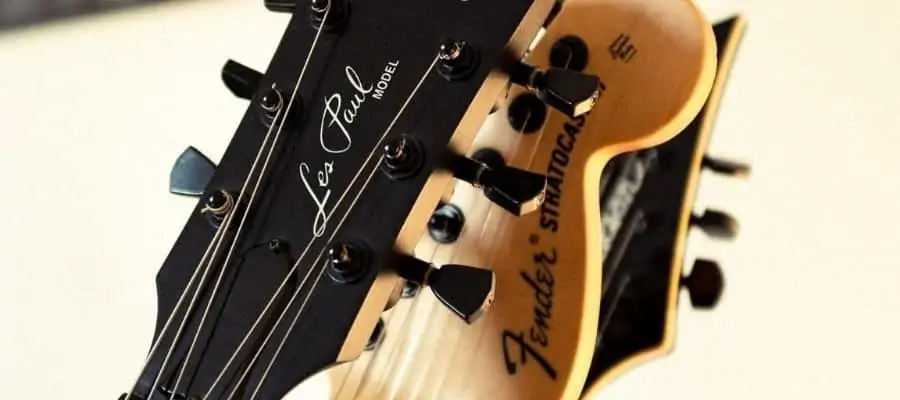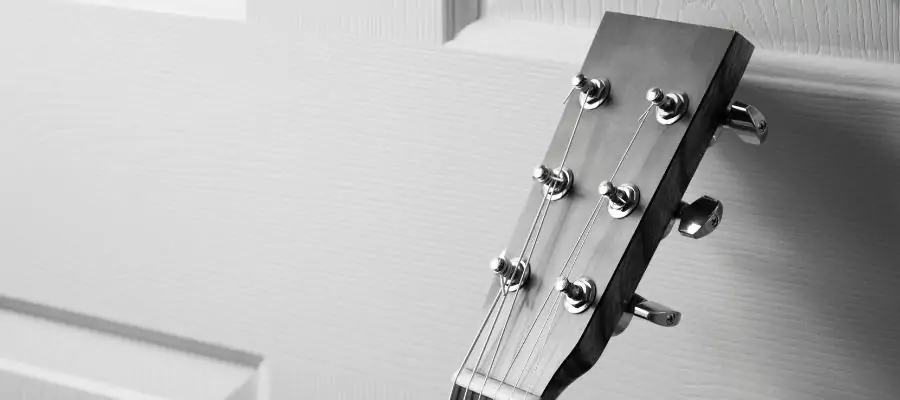Whether you are looking to buy a new guitar, or upgrade the one you already own, you might be thinking about getting locking tuners. Over the years, the popularity of locking tuners is only growing, and more and more companies are using them in their stock models.
But what are locking tuners? Are they a good improvement or something that might not be the right thing for you? Here, you will get an opportunity to learn everything you need to know about locking mechanisms, benefits, as well as disadvantages that come from owning these types of tuners.
What Do Locking Tuners Do?

So, let’s start from the beginning. If you are not familiar with locking tuners, the first thing you need to know is what their purpose is and how they can help you.
Locking tuners are a type of tuners used to keep strings in place and prevent them from coming loose. Now, there are many different types and versions of locking tuners, and each company will try to add something different and new.
Based on the type of your guitar, bridge, your playstyle, and everything else, you will pick one of the models that will suit your needs.
Using these tuning machines, you will have an easier time restringing your guitar, and you won’t need as many windings as with regular ones. Many players prefer using locking tuners to regular ones for various reasons. And the best thing is they look rather similar.
You won’t have to sacrifice the looks of your guitar for this upgrade. The primary idea behind the locking tuners is eliminating the string slippage. Naturally, the intonation and staying in tune is one of many problems you might experience.
Furthermore, whenever you play a note or bend a string, it will shift on the peg. Now, this string movement may reduce its life or detune your guitar. Either way, getting a locking tuner can significantly help along the way.
How Much Do Locking Tuners Cost?

The price of locking tuners mostly depends on the quality and manufacturer. If you are looking for high-quality ones, you will need to pay a bit more.
Locking tuners can be as cheap as $25, but the more expensive ones are around $60-$70. Of course, I would highly recommend avoiding the cheapest models, and if you are looking to invest in your guitar, you should do it properly.
If you are looking for the best locking tuners you can check out my post Top 10 Guitar Locking Tuners For A Consistent Tuning
Among the most popular brands for tuners are Fender, Grover, Schaller, Gotoh, and others. If you buy the cheapest possible tuners, there is a high chance that you won’t feel any improvement at all.
Moreover, it is more likely for you to get something that’s even worse than the tuner you already have. As with everything else, the most expensive product doesn’t necessarily mean that it will be the best one, and you can always find something in the mid-range.
The safest option is, of course, sticking to brands that have proven over the years to be the best in the business.
Interestingly, the prices of regular tuners are almost identical, and buying ones with locking mechanisms doesn’t mean you will need to spend more. It is a personal preference and the price is the same, at least for the same brand.
For example, Fender’s locking tuners and classic vintage-style ones are both $54, and it’s up to you to pick which ones you like more.
How Do Locking Tuners Work On A Guitar?

With regular tuners, you will pull the string through the hole on the peg and start winding. After a couple of turns, the string will be wrapped around the tuning peg, and you can proceed to the next string. Usually, musicians will have two or three winds on each string.
Locking tuners, on the other hand, work slightly differently. With locking tuners, you won’t wind a string around the peg a couple of times. Instead, you will push it through and engage the locking mechanism. As a result, you can wrap the string around the peg half a wrap or a bit more.
This means that the tuner will hold the string in place using the mechanism instead of friction and several windings. If you use too few windings on a regular tuner, the string will loosen and it will be quite difficult to stay in tune.
But here, the mechanism will do the work for you, and you won’t need to worry about anything. Just place the string, and tune your instrument. Of course, the locking mechanism may be different from model to model, and each company designs different tuners, but the idea is the same.
Do Locking Tuners Help Stay In Tune?

As I already mentioned, locking tuners prevent the string from slipping once it’s placed on the tuning pegs. Consequently, locking tuners will help your guitar stay in tune. So, the answer is yes.
If you are looking for a way to improve your tuning and secure the strings, locking tuners are the way to go. This is especially important for players who love using the whammy bar and vibrato technique since both can significantly detune the instrument.
I should mention that the effect is not the same as having a locking nut or Floyd Rose, and you might still experience detuning while using your tremolo too much.
Of course, locking tuners are designed to prevent the slippage of strings and not to ensure that your guitar never goes out of tune. It is just one of the ways to improve the tuning stability of your instrument.
However, there are a couple of reasons why your guitar might go out of tune, and not all are related to tuning pegs. For example, the nut, bridge, types of strings, and playing technique can all play a role in your tuning stability.
But there is no secret that tuning pegs can help, at least to a degree.
Do Locking Tuners Affect Tone?

One of the major differences between regular and locking tuners is their weight. Locking tuners are a bit heavier, and you might feel it on the headstock. Many players enjoy the feeling of the heavier headstock, and that makes the difference in their playstyle.
However, locking tuners does not have any effect on the tone. If the player feels different and can notice the change in weight, then their playstyle might change as well. The difference in tone will then be from a change in technique.
But locking tuners just keep the strings in place and have no impact on the tone. At least if you place the strings correctly. If you do something wrong, you might get the dull sound from the string, but it’s highly unlikely.
As you probably know already, the electric guitar uses pickups to create sound. The most important thing that affects the tone is the type of pickups and the amplifier you’re using. While each other part of the guitar and equipment will contribute to the sound it is not as nearly as important as pickup/amplifier combination.
With a different combination of wood, the player might notice a difference while playing unplugged, but on stage with other instruments, the difference will be unnoticeable. This means that you can replace your tuners with locking ones if you feel like it without any fear of tone change.
Are Locking Tuners Worth It?

Since locking tuners have almost the exact price as regular ones, the answer is yes. At least if that’s something you enjoy. For players that aren’t really fond of locking tuners, it might not be worth it.
But assuming that you are looking for something different and that you enjoy the idea of having locking tuners, then the answer is positive. Naturally, each player is unique and we all enjoy different things.
There is no secret that locking tuners are great, and they do a great job speeding up the process of restringing guitars. Moreover, you will avoid slippage of strings, as I already mentioned.
The first thing many players will do is check the price, and wonder if those few extra advantages are worth the difference. However, since there is no change in value between regular and locking tuners, the answer is obvious.
Do I Need Locking Tuners?

The answer to this question can be a bit complicated. Each player has their own preferences, and while some might hate the idea of having the locking tuners, others will think the opposite. For some, installing locking tuners is the first thing they do when they buy a guitar, and for them the answer is obvious.
So, do you need locking tuners? You don’t need locking tuners, per se. But they can be quite beneficial to you as a player if you like experimenting with “new” tech. Especially if you are a touring guitarist, you might enjoy the idea of shortening the time needed for restring.
It is more than obvious that the answer to this question is subjective and each player will see it differently. And that’s normal. There’s no reason to try these tuners if you don’t feel like it. On the other hand, they are more than useful with little to no drawbacks.
Furthermore, considering that they cost the same, you can always upgrade your guitar and try them yourself.
Why Would You Want To Use Locking Tuners?

One might think that if they don’t actually need them, why would they want to use locking tuners. This type of tuning mechanism is a great way to upgrade your guitar, and they come with a lot of benefits.
So, why would you want to use them? The answer is simple. You will spend a lot less time restringing your instrument, and you will improve the tuning stability. At least to a degree.
If you have an expensive guitar, you might not want to change anything on it. But low-end, and even mid-range guitars can often have bad tuners.
One of the most common problems with cheaper guitars are bridges and tuners, and if you want to continue playing your instrument, you might want to consider replacing these parts. While this might not serve as a rule, and it is possible to find a guitar with decent tuners, it is not as common.
And if you plan on replacing the old tuners, why not try locking ones. Of course, this doesn’t mean that you can’t put locking tuners on Les Paul or Stratocaster, and there are many players who will do just that.
Either way, it is a nice upgrade that won’t cost you a fortune.
How To Use Locking Tuners?

The very idea behind the locking tuners is to replace the string easily and without spending too much time. So, the process of changing a string is rather simple.
The first thing you’ll do is remove the old strings if they are still on the instrument. After that, you should adjust the position of tuning pegs. Usually, players enjoy placing the strings at an angle, instead of straight through the peg.
So, what you should do is adjust each tuning peg to a position you like so that each string enters the tuning machine at a certain angle.
Unlike regular tuning machines, you won’t need to leave the extra string. Just pull it through the hole, and turn the knob on the back of the tuner. Of course, if you can’t push the string through the hole, you should ensure that the screw behind the tuning peg is loose.
Once the string is inside the tuning peg, just screw the knob and it will secure the string. You can then cut the excess string like you normally would, and you can tune it to the appropriate pitch.
The process is the same for each string, and you will continue doing this until you restring the whole instrument. The main reason why the process is so fast is that you don’t need to wind each string a couple of times around the peg, and the mechanism will keep it secure in the place.
Once the instrument is ready, you can start playing. Now, playing the guitar with locking tuners is no different than playing the guitar with regular tuning machines. The only difference is in restringing.
Finally, if you want to change strings again, you will simply turn the knob on the back and the string will come loose.
How To Install Locking Tuners?

Now that you understand the process of changing strings, and how easy it is to restring the instrument, there is one more thing you should learn. And that’s how to install locking tuners.
The first thing you’ll need to do is to remove the old tuners that are already on your guitar. Naturally, the process will depend on the type of guitar and type of tuner that is installed. For most guitars, there is either a nut at the front side of a headstock or a screw on the back.
Now, the main problem with locking tuners is the type of guitar you have. If you get Fender’s locking tuners, and you want to place them on your Fender guitar, there won’t be any problems. But the process is often a bit more complicated.
The reason for this is that each company creates different guitar parts and this means that the holes on the headstock might not fit the tuner.
If you buy locking tuners with pins, and your headstock doesn’t have holes for these pins, you will need to do some drilling. Now, many people hate the idea of drilling their guitars, which is why you should carefully check the type of tuners you’re going to buy.
Similarly, the size of tuners might be too big for the hole on the headstock. As a result, you will need to expand the hole so the new tuners can fit properly.
Of course, you can always find a professional that will do the job for you, and they will do a great job even if there is a need to drill holes. So, be sure to find the appropriate tuners if you don’t want to do some woodworking on your instrument.
Pros And Cons Of Locking Tuners?

Let’s start at the beginning. Firstly, upgrading your tuners will improve tuning stability to a degree. But more importantly, it will prevent the slippage of strings. With regular tuners, the string won’t be secured at the tuning peg and will be able to move.
The second factor that is a great advantage is how quickly you can replace strings. If you are playing at home, you might not care about the time you’d spend changing strings. But if you are touring, every second can be important especially if your string breaks during the show.
Whether you love or hate restringing your instrument, the whole process is a lot simpler and quicker.
If you get appropriate tuners, you won’t need to drill any holes, and you can simply pop the old tuning machines and replace them with new ones in no time.
However, there are a couple of disadvantages as well. The most obvious one is that you will need to find the ones that suit your guitar. Now, this might not be a problem for any expensive guitar, but if you have some less-known brand, you might need to do some drilling.
I already mentioned before that locking tuners are a bit heavier, and you might need some time to adjust to the new weight of the headstock. For some players, this might lead to a “meaty” tone, but for others, it poses a major disadvantage.
Furthermore, locking tuners might improve your tuning stability, but they will not solve the problem. Tuning pegs are just one of many reasons why you might experience tuning problems, and there is a high chance that it won’t disappear even if you buy new tuning pegs.
Finally, many players perceive them as “too much” and they would rather stick to the old methods.
How To Find Locking Tuners For Your Guitar?

You might want to know how to find the tuners for your guitar. Try finding the locking tuners that are identical to the ones you already have. This includes all the screws and nuts that are already on your tuning machines.
This way, you will avoid having to drill extra holes or expand existing ones to fit the new tuning machines.
Naturally, if you don’t mind paying for a professional luthier, you can get nearly any type of tuning machine, and they will do the work. But you should be prepared to pay a bit more for the extra work.
To avoid having to do any extra work, just remove one of the tuning pegs from your guitar and see how it looks like. Usually, locking tuners will have two pins, and if your old tuners have them as well, then you can find a similar one.
Furthermore, be sure to measure the width of the peg (or the hole) to see if the new one will be fitting. Similarly, if there are no pins on your old tuners, try finding locking ones with a similar design.
Finally, once you find the one that will fit the headstock, you can pick the color that will match your guitar or the one you like the most.
On What Kind Of Guitars Can You Use Locking Tuners?

Interestingly, you can use locking tuners on any type of guitar. That includes electric and acoustic as well. While it is not as common to use locking tuners on acoustic guitars, it is still something you can do if you desire so.
If you plan on buying these tuning machines, just ensure that they are the right type and that they can be mounted on acoustic guitars.
Furthermore, you can also experiment with these upgrades even if you have an electric guitar with more than six strings. Finding parts for seven-string guitars can be challenging, but locking tuners will still do a great job.
Similar to previous examples, you might need to do a bit of drilling to ensure that everything fits properly.
Naturally, if you don’t want to mess with this kind of work yourself, you can always take it to the luthier or local music shop and let them do it for you. It’s easier, and there is no chance that anything bad will happen to your instrument.
Summary
Locking tuners are an excellent upgrade for guitars, and you can do it no matter what type of guitar you have. It is the easiest way to secure the strings and prevent slippage.
Usually, the string will move whenever you bend (or play) the note, and it can slip across the peg. With locking tuners, there will be no excess string that can move, and it will slightly improve the tuning stability.
The main problem with locking tuners is that you often need to drill additional holes to make everything fit properly, and many guitarists are unwilling to try this by themselves.
While locking tuners do a great job keeping your strings secured, it is not the only way to improve tuning stability. Moreover, there is a high chance that other parts of guitars are the problem if your guitar can’t stay in tune.
Since the price of locking and regular tuners is almost the same, it is up to your personal preference to see which ones you like the most. For some players, locking tuners are an essential part of every guitar, and they love using them.
So, if you are willing to experiment a bit, try them out and see if this is something you’ll enjoy.
If you found this article useful, you may want to save this pin below to your Guitar board.

4 thoughts on “Everything You Need To Know About Guitar Locking Tuners – 13 Q&A”
Leave a Reply
Recent Posts
Some guitarists insist on buying an expensive amplifier with their electric guitar. They assume that this is a must for every type of guitarist out there. However, in some situations, this isn’t...
Top 50 Free Realistic Guitar VST Plugins With Sound Examples
As technology has rapidly advanced in the recent decade, computers are stealing more and more roles from physical musical instruments and accessories. Nowadays, you do not need expensive amps,...


Thank you, that was very helpful. I have been playing since 1985. Just a shade tree guitarist and off and on. I’m building a strat kit and thinking about the tuners but didn’t know what locking tuners are. Good job I now have a working knowledge of locking tuners.
glad I could help Andy!
Thank you, that is very helpful. I was looking for compatible locking tuners, but I am an older female / beginner guitarist, who chose the lightest, smallest scale guitar I could find, so now that I know locking tuners add weight, I am reconsidering. I must add: I find it odd that guitar makers like Fender cannot (or will not?) include a list of the guitar models that their locking tuning machines can fit. Obviously people need to know this, and the company designing the Fender and Squier guitars should know which locking tuners fit or don’t fit, and provide that information online.
Hi Sarah,
I’m glad I provided you some insights on that.
As for including which locking tuners fit which brand and model, it is up to the manufacturer of the locking tuners to provide all the information you need.
you just need to take measurements of size of the holes and the distance between them with a caliper ruler on the guitar you want to upgrade.
With that information look for the appropriate locking tuners.